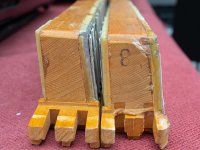jakubko123
Newbie
Hi guys!
Do you know what is causing this rattling sound and how to repair it? It is a bass reed in a diatonic Hohner accordion and I put new valves and wax in it and tuned it. I thought there was some metal piece on the reed tongue that would form such sound while playing so I filed around the reed tongue but it didn't help. (The sound can be heard only when pushing the bellows harder and this is the only reed playing like that.)
Please help
Do you know what is causing this rattling sound and how to repair it? It is a bass reed in a diatonic Hohner accordion and I put new valves and wax in it and tuned it. I thought there was some metal piece on the reed tongue that would form such sound while playing so I filed around the reed tongue but it didn't help. (The sound can be heard only when pushing the bellows harder and this is the only reed playing like that.)
Please help

